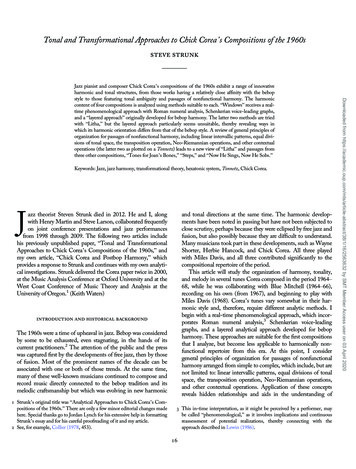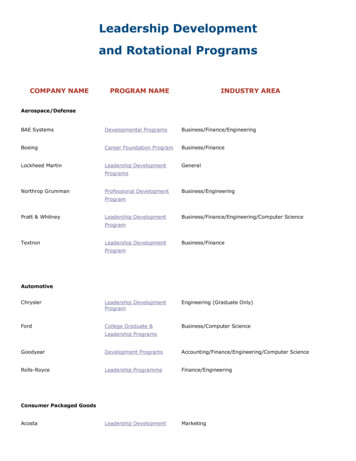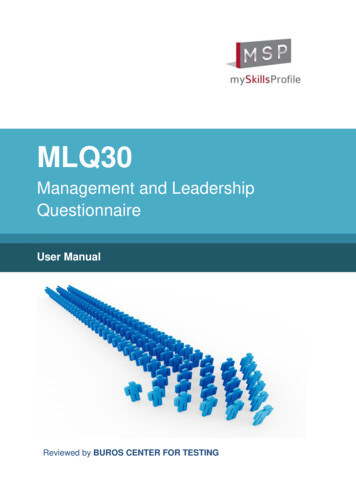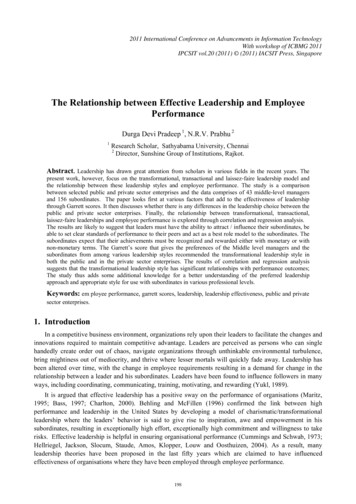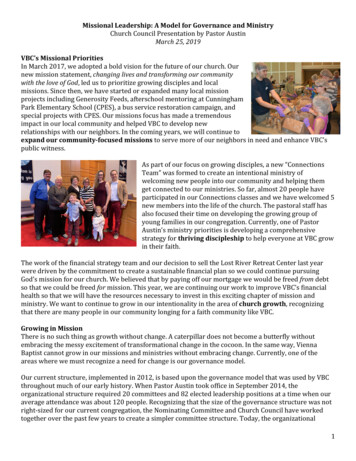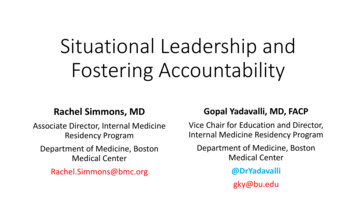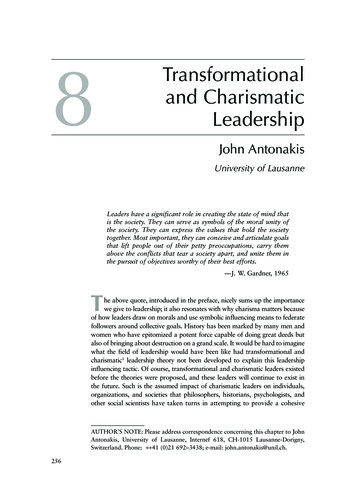
Transcription
8Transformationaland CharismaticLeadershipJohn AntonakisUniversity of LausanneLeaders have a significant role in creating the state of mind thatis the society. They can serve as symbols of the moral unity ofthe society. They can express the values that hold the societytogether. Most important, they can conceive and articulate goalsthat lift people out of their petty preoccupations, carry themabove the conflicts that tear a society apart, and unite them inthe pursuit of objectives worthy of their best efforts.—J. W. Gardner, 1965The above quote, introduced in the preface, nicely sums up the importancewe give to leadership; it also resonates with why charisma matters becauseof how leaders draw on morals and use symbolic influencing means to federatefollowers around collective goals. History has been marked by many men andwomen who have epitomized a potent force capable of doing great deeds butalso of bringing about destruction on a grand scale. It would be hard to imaginewhat the field of leadership would have been like had transformational andcharismatic1 leadership theory not been developed to explain this leadershipinfluencing tactic. Of course, transformational and charismatic leaders existedbefore the theories were proposed, and these leaders will continue to exist inthe future. Such is the assumed impact of charismatic leaders on individuals,organizations, and societies that philosophers, historians, psychologists, andother social scientists have taken turns in attempting to provide a cohesiveAUTHOR’S NOTE: Please address correspondence concerning this chapter to JohnAntonakis, University of Lausanne, Internef 618, CH-1015 Lausanne-Dorigny,Switzerland. Phone: 41 (0)21 692–3438; e-mail: john.antonakis@unil.ch.256
Chapter 8 Transformational and Charismatic Leadershipexplanation of what I think is probably one of the most interesting pieces ofthe leadership puzzle.Transformational and charismatic leadership theory has had a massiveimpact on leadership as a scientific domain. This leadership approach wascharacterized by Bryman (1992) as the “new leadership,” such was its breakwith existing leadership models. In a way, when transformational and charismatic leadership theory came along, it provided leadership researchers the“ah-ha” moment for which they had been waiting for many years; it is almostironic to observe that in terms of its messianic explanations, the theory wasto leadership research what charismatic leaders are to followers (cf. Hunt,1999). That is, it delivered leadership researchers from their plight at a timewhere there was pessimism and no direction in leadership research; there evencame a time when researchers made calls to abandon leadership as a researchtopic (Greene, 1977; Miner, 1975). It is almost surreal to imagine that leadership, as a discipline, was not taken seriously; so when transformational andcharismatic leadership theory came along it was embraced in full earnest. AsI argue later, perhaps the pendulum has swung too far on the side of transformational and charismatic leadership theories, which have eclipsed andpossibly maybe stunted other important contributions to leadership.Transformational and charismatic leadership has been the focus of a greatmany research inquiries (Yukl, 1999); these approaches have helped shift theleadership paradigm to what it is today (Antonakis, Cianciolo, & Sternberg,2004; Conger, 1999; Hunt, 1999; Lowe & Gardner, 2000). This researchstream dominates the leadership landscape—whether deservingly or not—atleast in terms of published papers in the premier academic journal focused onleadership, The Leadership Quarterly, both in the last decade (Lowe &Gardner, 2000) and in the current one (W. L. Gardner, Lowe, Moss, Mahoney,& Cogliser, 2010).How did transformational and charismatic leadership theory develop? Whyis transformational and charismatic leadership so popular? Where is transformational and charismatic leadership theory heading? I will try to answer thesequestions and others in this chapter. First, I review some of the major historicalworks that provided the scaffolding for current theories of transformationaland charismatic leadership. In terms of the contemporary theories, I focus inparticular on Bass’s (1985) theory—known also as the “full-range leadershiptheory” or the “transformational-transactional” leadership theory (Avolio &Bass, 1991)—because it is the flagship theory of the transformational and charismatic movement (Antonakis & House, 2002). Although a part of my workhas focused on transformational and charismatic leadership (Antonakis, 2001;Antonakis & Atwater, 2002; Antonakis, Avolio, & Sivasubramaniam, 2003;Jacquart & Antonakis, 2010), I critically review this theoretical stream and inparticular its forbearer, Bass’s theory, highlighting some of its strengths andweaknesses. Given that I am “one of them”—that is, part of the charisma“leadership mafia” as Gemmill and Oakley (1992) would say—it is not easyfor me to take this step back and review the theory with a critical eye. AlthoughI pay my respects to the theory, my purposeful “friendly fire” highlights257
258PART III THE MAJOR SCHOOLS OF LEADERSHIPvoids and inconsistencies in the full-range theory (Antonakis & House, 2002;Antonakis, House, Rowold, & Borgmann, 2010); a theory can only beimproved if it can be challenged, and it is with this mindset that I am pokingsome holes in this model. Finally, I also briefly review competing transformational and charismatic paradigms and conclude with where transformationaland charismatic leadership is heading, or rather should be heading.Transformational andCharismatic Leadership: A Brief HistoryMost writers credit Weber (1947) for having coined the term “charisma”and having provided the first theoretical explanation of the impact of charismatic leadership on followers. I will get to Weber later to show how hisideas permeated leadership research. However, theoretical explanations of aphenomenon akin to charismatic leadership and the ways in which leadersshould go about influencing followers using potent persuasive means goesback much further in time. In fact, the writings of Aristotle (trans., 1954),appearing in the fourth century BCE, first laid these foundations and,indeed, the foundations to the field of rhetoric, which is a key foundation ofcharismatic leadership.In the Rhetoric, Aristotle argued that a leader must gain the confidenceof her followers by using creative rhetorical means (i.e., charismatic andtransformational), which include rousing follower emotions (the “pathos”),providing a moral perspective via her personal character (“ethos”), andusing reasoned argument (“logos”). It will become evident that these threedimensions, as well as other means which Aristotle referred to as being nonartistic (i.e., transactional and aversive reinforcing)—including contracts,laws, tortures, witnesses, and oaths—can be seen as a parsimonious versionof Bass’s (1985) full-range leadership theory. To better understand the startling insights of Aristotle, which not only touch on charismatic leadershipbut also on affect and cognitive psychology, as well as other areas of science,I quote from Book I, Chapter II, where he refers to the three kinds of rhetorical influencing:The first kind [of persuasion] depends on the personal character of thespeaker; the second on putting the audience into a certain frame ofmind; the third on the proof, or apparent proof, provided by the wordsof the speech itself. Persuasion is achieved by the speaker’s personalcharacter when the speech is so spoken as to make us think him credible. We believe good men more fully and more readily than others:this is true generally whatever the question is, and absolutely truewhere exact certainty is impossible and opinions are divided. This kindof persuasion, like the others, should be achieved by what the speakersays, not by what people think of his character before he begins to speak.It is not true, as some writers assume in their treatises on rhetoric, that
Chapter 8 Transformational and Charismatic Leadershipthe personal goodness revealed by the speaker contributes nothing tohis power of persuasion; on the contrary, his character may almost becalled the most effective means of persuasion he possesses. Secondly,persuasion may come through the hearers, when the speech stirs theiremotions. Our judgments when we are pleased and friendly are not thesame as when we are pained and hostile. It is towards producing theseeffects, as we maintain, that present-day writers on rhetoric direct thewhole of their efforts. This subject shall be treated in detail when wecome to speak of the emotions. Thirdly, persuasion is effected throughthe speech itself when we have proved a truth or an apparent truth bymeans of the persuasive arguments suitable to the case in question. (p. 7)I encourage readers to go back and read the above passage (and indeedAristotle’s entire book) once they have read this chapter and the section onthe “full-range leadership model” in particular. I find it a real eye-opener toread such classics and others like Plato’s Republic (trans., 1901); these worksprovided important foundations for western thought on topics concerningleadership, ethics, and good government. What I also find troubling by reading these works is why humanity is not more sophisticated and responsiblethan it currently is, when so much was known so long ago. Why do countriesstill go to war? Why is corruption still rife? Why is there still large-scale poverty and disease? Why is our ecosystem under threat? and Why are people soeasily duped by bad leaders?In essence, many of these problems are problems of leadership. It isonly recently that these problems of humanity have been scrutinized, aftera particularly regressive period during the dark ages, when science andreason were sidelined; science and reason in all their forms must bebrought to the fore and targeted toward better understanding the leadership process. Warren Bennis (this volume), who has over the decadesdemonstrated remarkable perspicacity about the problems of leadership,notes that “it is important to remember that the quality of all our lives isdependent on the quality of our leadership. The context in which we studyleadership is very different from the context in which we study, say,astronomy. By definition, leaders wield power, and so we study them withthe same self-interested intensity with which we study diabetes and otherlife-threatening diseases. Only when we understand leaders will we beable to control them.”Indeed, the most potent of leaders, charismatic and transformational leaders, are the ones who can bring about needed social change; although thesetypes of leaders have also been capable of dreadful deeds, which explainsBennis’s concern. Of course, my chapter does not provide a treatise on issuesconcerning the selection, development, and outcomes of leadership andrelated topics; this is the job of the entire volume. I focus on charismatic andtransformational leadership, though I will touch on some of these otherimportant issues where relevant. Next, I discuss the most important contributions to this research stream (chronologically).259
260PART III THE MAJOR SCHOOLS OF LEADERSHIPThe Weberian PerspectiveWeber (1947) was the first to use the term “charisma” and describe thecharismatic leader as one who could bring about social change. He identifiedthese types of leaders who arise “in times of psychic, physical, economic,ethical, religious, [or] political distress” (Weber, 1968). For Weber (1968),charisma in leaders referred to “specific gifts of the body and spirit not accessible to everybody” (p. 19). These leaders were attributed “with supernatural,superhuman, or at least specifically exceptional powers or qualities” (Weber,1947, p. 358), and could undertake great feats. Weber (1968) believed thatfollowers of a charismatic leader willingly place their destiny in their leader’shands and support the leader’s mission that may have arisen out of “enthusiasm, or of despair and hope” (p. 49). Weber (1968) argued that charismaticauthority is different from bureaucratic authority and that at the core ofcharisma is an emotional appeal whose “attitude is revolutionary and transvalues everything; it makes a sovereign break with all traditional or rationalnorms” (p. 24). Finally, Weber (1968) stated that the charismatic effect andlegacy of the leader may continue as artifacts of the organizational or societalculture, but then wane as the organization or society is enveloped in therational and methodical processes of the bureaucracy.What is interesting in the Weberian idea of the charismatic leader is theimportance of context and the apparent salvationary qualities of the charismatic leader. Also important is the notion of charismatic authority as beingdistinct from other sources of authority. Weber was not very clear on what,specifically, charismatic leaders do, and he was more concerned with ends thanwith means. Other sociologists continued in this vein (e.g., Shils, 1965). Wellknown is Etzioni’s (1964) structuralist perspective, which focuses on the effectthat formal leadership has on individuals and the source of power that is usedto exert influence over followers. Etzioni (1964) differentiated three types ofpower bases that leaders may use, namely: (a) physical power, entailing the useof threats or coercion; (b) material power, entailing the use of rewards; and(c) symbolic power, entailing the use of normative or social power (see alsoFrench & Raven, 1968). Symbolic power is what Etzioni (1961) referred to as“charisma” (p. 203). According to Etzioni (1964), greater commitment andless alienation will be displayed in followers when their leaders are using symbolic over material or physical power, and material over physical power.Downton’s Rebel LeadershipIn line with the Weberian notion of charisma, Downton (1973) proposed atheory of transact
these types of leaders who arise “in times of psychic, physical, economic, ethical, religious, [or] political distress” (Weber, 1968). For Weber (1968), charisma in
